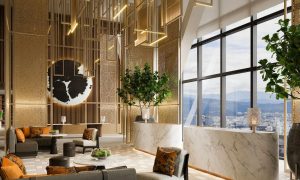[img_gallery][/img_gallery]
Though each of us can do our part to be more environmentally aware, the buildings we live and work in can function as green powerhouses if they’re thoughtfully built. Join Hugh Ujhazy as he looks at some of the efforts being undertaken in Malaysia to push the country towards a greener future.
Asingle 20-story concrete-and-steel building releases 1,400 tons of carbon into the atmosphere each year. Though construction accounts for 47% of the world’s total annual greenhouse gas production, office buildings are not far behind, contributing 35% of this amount.
Creating flexible, functional, friendly buildings that reduce greenhouse gas emissions is the challenge. Dealing with the issues around a tropical environment dominated by heat and humidity adds an additional level of challenge to the equation.
Jeffrey Cheah, a regional architect based in Malaysia, notes that there are answers and alternatives, especially where lessons are drawn from local housing solutions. “Wood draws and stores carbon,” he says, “whereas concrete and steel release carbon.” The lessons from kampung houses with their wood construction, large overhangs, high ceiling spaces, and small windows provide a working blueprint for green housing in a tropical climate.
Cheah points to the Leadership in Energy and Environmental Design (LEED) certification program which lays down a number of considerations when building or renovating structures. “It’s not all about the use of energy sources or recycling,” notes Michael Green, a Canadian architect and proponent of wood as an alternative to concrete and steel. “Though choice of energy sources is important, and approaches like solar and wind power can be effective, the choices made in materials and the environment for a residence have a major impact.”
“It comes down to landscaping and water use,” adds Cheah. Two of the principle components of LEED are water efficiency and sustainable sites. “Many of the newer buildings in Malaysia are surrounded by lush landscaping and water features,” says Cheah, explaining that the use of landscaping as a green solution is not immediately obvious. “Greenery planted around a building, be it a house or an office building, will both provide shade, thus reducing the need for mechanical cooling, and soak up carbon by trapping it in the trees and plants,” Green further notes. Creating a planted environment not only beautifies the environment but actually cuts down on the cost of mechanical cooling systems.
Further environmental factors, like access to public transport and encouraging use of bicycles, not only make it easier for people to get to the building but reduce the daily stress of being stuck in traffic, examples of which can be seen in the Diamond Building in Putrajaya, home of the Malaysian Energy Commission, typifies a number of the energy efficiency elements. The building is surrounded by greenery, has ample parking, and offers support for alternative transportation. Its walls expand from the base, providing natural shade from the sun and reducing energy expenditure for cooling. Combined with tinted glass on the exterior of the building and low-energy lighting, overall mechanical expenditure is reduced.
See Also: The Diamond Building in Putrajaya
Storm water runoff is also alleviated by the local landscaping plantings and diversion of rainwater to pools and plant beds adjacent to the building. Finally, the interior construction of the building encourages the flow of air up through the central atrium to the roof opening, allowing for a continuous recycling of interior air to reduce heat build-up.
The lessons from buildings like the Diamond Building are also applied to residences. A 12,000 square foot residence in Damansara Heights applies many of these techniques. Much of the construction is local wood. The roofline of the house overhangs the walls, providing much-needed shade, a complemented by extensive plantings up to the side of the house, further reducing heat buildup in the structure. The open planning of doorways, arches and the use of small window openings manage the airflow through the building and minimize reliance on mechanical cooling systems. A large water feature and swimming pool provide additional local cooling through evaporation.
These principles can be scaled up from one bungalow to a large residential complex by applying basic principles including recycling and reusing, energy efficiency, rainwater harvesting, and natural ventilation. An upcoming condominium in Kuala Lumpur aims for the green outlook by utilizing increasingly popular open sky terraces with planter ledges, and “private” gardens for each residence, thus encouraging the planting of material. Similar to the Diamond building, visually appealing and naturally beautiful landscapes can provide scenic views and fulfill green requirements.
The use of materials remains a key factor. Wood and other renewable materials will lock up carbon when incorporated in a building. Michael Green notes that recent projects in Australia have pushed the height limits on wooden building to over 10 stories. “To make a real difference, we have to look at alternatives to steel and concrete. Wooden skyscrapers are a real and viable alternative, especially where fast-growth wood is used.” Green notes that while a typical 20-storey steel and concrete building will produce around 1,400 tons of carbon annually, a similar structure built from wood actually locks up on 3,000 tons, a net saving of 4,400 tons or the equivalent of removing 900 cars from the road for a year.
It’s not just the materials themselves but also the road they travel. “Local is best,” offers Jeff Cheah. “The transportation of materials to a construction site, whether it is new build or renovation, places a major carbon burden on the project.” So granite from India or Malaysia versus marble from Italy can reduce the carbon burden involved in getting it from point A to B. Even if the material must come from far a field, the adhesive, paints, and other finishes can also have an impact. Low vapor paints and adhesives, along with the choice of flooring systems (renewable alternatives like bamboo, rubber, and cork are popular), help reduce the burden of carbon imposed by a residence or office block.
Finally, energy must be considered. When discussing the abundance of solar energy on offer in Malaysia and the lack of use of such technologies, suggestions abound. The principal answer seems to be the relative cheapness of energy. “In the US and Australia, when commercial power increased in cost due to oil prices and transportation costs, alternative energies came into their own. Help from the governments to promote installation of such technologies through tax rebates and incentives also helped,” says Michael Green. “As long as energy from commercial sources remains inexpensive, the incentive to utilize alternative energy sources in reduced,” adds Cheah.
That said, energy demands of the structure can be reduced by putting it in the right place. “Putting walls on the east-west axis and windows on the northsouth alignment helps reduce cooling requirements,” says Cheah. Complement that with plantings and landscaping along the sun exposed walls and the benefit multiplies.
“Green architecture and construction is not about doing just one thing,” Green insists. “It’s about using all the tools available and borrowing from the lessons learnt when energy was not cheap and heating and cooling depended on making the right choices.” Cheah agrees: “Even if it’s a renovation, even if you have open land around your existing house, making choices will impact the green contribution of where you live today.”
Source: The Expat January 2014
Read more: What it Means to be Green
What are your thoughts on this article? Let us know by commenting below. No registration needed.


















